

(Katsumasa Maruo, Senior Specialist for Archival Affairs at JACAR)
2. Outreach Activities
- Publicity Work
3. Information on Related Document Holdings "The Condition of Japan Related Materials in the United States of
America"
- Suzzallo and Allen Library and East Asia Library, University of Washington
- The National Archives at Seattle
- The Boeing Archives
4. Event Informations on the Related Organs
- National Archives of Japan
- Diplomatic Archives of the Ministry of Foreign Affairs
Learning about Prewar Diplomatic Telegrams and Official Notes
The Ministry of Foreign Affairs has released many documents through Japan Center for Asian Historical Records. A lot of the records contain communications between the Ministry of Foreign Affairs with overseas missions and offices. Since the antiquated style of the records can be difficult for even Japanese to read, I will explain how to make sense of official telegrams and official notes from the prewar period.
As a primary means of international communications for the Ministry of Foreign Affairs, telegrams once allowed for electric signals to be exchanged rapidly, sending urgent information across the world. Official notes were also an option for diplomats and others to send documents that bore seals as well as physical attachments.
Let us proceed to discuss how to read official telegrams. [Image 1] is a telegram that was sent on the afternoon of November 19, 1938 from the Consulate in Zhangjiakou, China to Tokyo's Ministry of Foreign Affairs (Reference Code: B08060824300). The serial number on the telegram is written in the upper part of its first line and the character "略" can be found under the number. The character "略"means that the telegram was encoded without a complex cipher. If the telegram were encoded more, the character "暗" would be written. And if the telegram was not encoded at all, the character "平" would be written. The time the document was sent can be found under the character. At the bottom of the same line, you can locate the bureau or the division which was in charge of the telegram's content.
In this case, the bureaus responsible for the content are the Asian Bureau and the Trade Bureau. The addressee (Minister of Foreign Affairs) and the time of reception (night of November 19th, 1938) are found in the second line. In the upper part of third line, information is included on who sent the telegram. And in the lower part of this line, you can find who received the telegram.
In general, telegrams were sent and received in the name of the Minister of Foreign Affairs and the chiefs of overseas establishments. In this specific case, the telegram was received by the Minister of Foreign Affairs and sent by the Consul in Zhangjiakou. The serial number of the Consulate in Zhangjiakou that sent the document can be found on the fourth line. The title of the telegram is written in the fifth line: "On Taxation for Foreign Cigarettes by the Autonomous Government of Inner Mongolia." With telegrams like this, when they were sent other organizations would receive copies of the content, similar to how emails are carbon copied today, and in this case telegram copies were sent to Beijing's Embassy to the Republic of China and to the Consulate in Tianjin.
Most of individuals working overseas in offices for the Government of Japan, including chiefs, were under the supervision of the Foreign Affairs minister. However, military attaché of the Army and the Navy, who also worked overseas, were under the supervision of their General Staff Office, instead of a Foreign Affairs minister. Consequently, a military attaché would have sent telegrams as opposed to a Foreign Affairs minister (For an example, see "Military attaché of the Embassy of Japan in USSR to the Deputy Chief, General Staff" (Reference Code: B02030780300). Moreover, you can find an example of a telegram between an overseas office and the East Asia Development Board (Reference Code: B08060393500, 1st image), and a telegram between overseas offices and the Ministry of Greater East Asia (Reference Code : B08061208000, 1st image).
Let us proceed to discuss official notes. [Image 2] is that of a note sent from the Consulate in Shanghai to the Ministry of Foreign Affairs with the document "Measures for Central Chinese Ideology." In the first line, there is a note serial number. In the second line, the date it was sent is written (December 8th 1938). In the third and fourth lines, you can find the phrase "Consul-General in Shanghai, Shinrokuro Hidaka," and you can learn that this note was sent in the name of the Consulate in Shanghai. Such matters are always clear with official notes, as they contained seals of the person overseeing it. In the fifth line, the name of the Minister of Foreign Affairs who received the note is written. In the next line, the title "Transmission of Summary of 'Measures for Central Chinese ideology' etc" is written. This indicates what was sent with the note. In the last line, the phrase "addressees of note copies" is written and the addressees were "Counselors of the embassies in Beijing, Tianjin, Hong Kong, and Guangdong." Thus the document information was also shared with the embassy in Beijing, the Consulate-General in Tianjin, Hong Kong, and Guangdong.
![* Click to Enlarge [Image 2] Title : 1. Exchanges of telegrams and official communication concerning measures for China Incident / 2. Transmission of summary, etc., of measures for Central Chinese ideology (1st image)](img/021_content01_02_01.jpg)
[Image 2] Title : 1. Exchanges of telegrams and official communication concerning measures for China Incident / 2. Transmission of summary, etc., of measures for Central Chinese ideology (1st image)
Such notes were sent and received formally between Foreign Affairs ministers and the heads of overseas offices. However, when official notes were inappropriate for communicating personnel matters or more private issues, alternative forms of communication were used. One form was the private letter or "hankoshin". [Image 3] is an example of a private letter exchanged (Reference Code: B07080579000). In the letter, as is with official notes, a serial number from the sender and a date as well as the addressee are written from the right for the overseas organization. However, [image 3] differs in two ways.
First, the origin is not the chief of an overseas office nor is the addressee a Foreign Affairs minister. The letter "Hankoshin" was the informal means of communication, and is therefore the communication between the persons directly in charge of the content. The other difference is in the style of the official note. It was similar to private letters, so the phrase "Dear Sir" or "拝啓陳者" could be written at the start, and the phrases "I would like to reply, Sincerely yours" or "此段得貴意候 敬具" could be written towards the end. The official note and the private letter were used in order to communicate between the Ministry of Foreign Affairs and other ministries or local governments overseas.
[References]
Koike, Seiichi. Modern Japan Document Studies Introduction. Tokyo: Gendai Shiryo Shuppan, 2008, pp. 125-128. (In Japanese)
Koike, Seiichi. "Generating Process of Documents and Records by the Ministry of Foreign Affairs: Trial in the Archival Study on documents by the Ministry of Foreign Affairs". Hihon Rekishi 584 (1997): pp. 1-15. (In Japanese)
Sakano, Masataka. Analysis of Diplomacy in the Modern Period. Tokyo: University of Tokyo Press, 1979. (In Japanese)
Yagishita, Hiroko. "History of the Style of Official Telegram at the Ministry of Foreign Affairs in the Pre-war Period". Journal of the Diplomatic Archives 15 (2001): 106-122. (In Japanese)
Yagishita, Hiroko. "Research on the History of the Style of Official Letters at the Ministry of Foreign Affairs in the Pre-war Period". Journal of the Diplomatic Archives 6 (1993): 40-50. (In Japanese)
-Overseas
|
September 5-9, 2016
|
JACAR Director-General Sumio Hatano gave a speech titled "Challenges of Two Digital Archive Systems at the National Archives of Japan" at the International Council on Archives (ICA) Congress in Seoul. (→2016 ICA Congress Presentation Handouts Prepared by Japanese Speakers on the National Archives of Japan website)
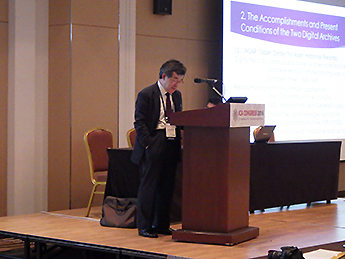 Director-General Hatano's speech |
|
September 12-23, 2016
|
Held booth exhibition with workshop and had session at 2016 European Association of Japanese Resource Specialists (EAJRS) conference in Bucharest.
Had discussions about researching archival documents with members of the National Archives of Romania in Bucharest.
Had discussions about researching archival documents with members of the Philological Library of the Free University of Berlin.
Had discussions about researching archival documents with members of the Political Archive of the German Federal Foreign Office in Berlin.
Had discussions about researching archival documents with members of the Berlin State Library.
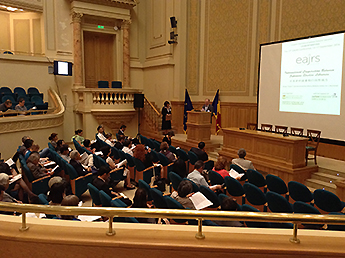 EAJRS Conference |
-Domestic
|
July 27-28, 2016
|
Exhibited at Association of Education and Research on History the 57th Annual Conference at Urawa Community Center.
|
|
October 16, 2016
|
Exhibited at the 102nd All-Japan Library Conference at Aoyama Gakuin University
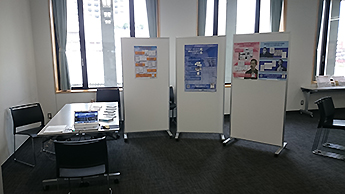 JACAR Booth at the conference |
|
November 7-8, 2016
|
Presented at the 5th International Academic Conference of the Institutes for Research and Editing of East Asian Historical Resources at the Historiographical Institute, the University of Tokyo.
|
|
November 8-10, 2016
|
Exhibited at the 18th Library Fair & Forum at Pacifico Yokohama.
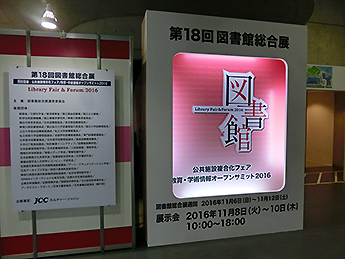 18th Library Fair & Forum |
|
November 16-17, 2016
|
Presented and held booth exhibition at the 64th Annual Conference of the Japanese Association of Museums at Gunma Music Center.
Had discussions about researching archival documents with members of the Gunma Prefectural Archives.
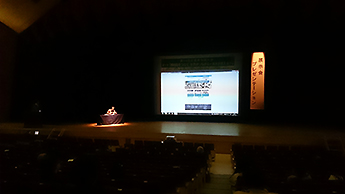 JACAR's presentation at 64rd Annual Conference of the Japanese Association of Museums |
The Condition of Japan Related Materials in the United States of America
This past March JACAR staff members Hiroko Matsuo and Muneaki Hirano visited two American organizations that house Japan related materials. The pair from JACAR conducted interviews about archival digitization and investigated the conditions of materials related to Japan. The conditions of the three visited organizations are outlined below.
The University of Washington (UW) is a public university located in Seattle, Washington. There are fifteen research libraries in addition to the university's central library, the Suzzallo and Allen Library. Some of the university holdings, especially in the East Asia Library, include materials pertaining to Japan.
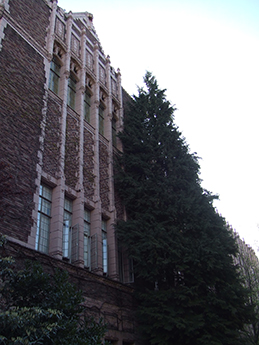
The East Asia Library
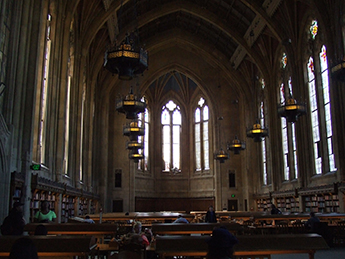
Reading Room in the Suzzallo and Allen Library
The East Asia Library opened in 1937, after the university purchased a small collection of Chinese literary works. During the 1940s, this unnamed collection had increased to 20,800 volumes, including a gift of 2,000 volumes from Columbia University. It was shelved in Suzzallo Library's Oriental Seminar Room. When the Far Eastern Institute was established in 1946, the collection became an independent library, the Far Eastern Library. After that, the Japanese and Korean library collections began to increase with the George Kerr Collection and a small number of Korean titles were assembled during World War II for U.S. Army teaching purposes. Towards the beginning of the 1950s, the library acquired Japanese materials on China, as well as the Joseph Rock and Herbert H. Gowen collections to further enhance the Library's holdings on China and Inner Asia. In 1976, the Library moved in Gowen Hall, where it remains today, and it was renamed the East Asia Library. In this library, collections have continued to grow rapidly and automation was introduced during 1980s. This complemented the addition of electronic materials about East Asia that were acquired in the 1990s. The library was the first institution outside China to acquire the Twenty-Five Dynastic Histories database and the first academic library in North America to establish a direct connection to the NACSIS-IR service in Japan. As of June 2015, the library has over 683,000 volumes of publications on East Asia in Chinese, Japanese, Korean, Tibetan, Manchurian, Mongolian, and other languages.
In the university libraries, there are a total of 320 employees and librarians, including 50 special subject librarians who construct and manage the collections, apply subsidies to purchase materials, control the budget, and provide reference services for departments. The East Asia Library has one subject librarian, one cataloguer, and one acquisition assistant assigned for each of Japan, China and Taiwan, and Korea subject.
In the East Asia Library, which is classified as a departmental library, subject librarians select and purchase materials through discussions with the university's professors, students, and researchers. The librarians collect materials based on the Collection Development Policy which they develop and approve. Many U.S. university libraries have similar collection policies, because they are often built in reference to others.
The East Asia Library receives many donations of materials. The criteria for receiving donations are specified in the Collection Development Policy. Thedonations must satisfy the library's research purpose and not duplicate. As a recent case, within a batch of Japanese comics donated by a researcher, the library excluded items for which duplicate. The library declines in principle also non-academic materials like photo collections or strongly religious and political texts from organizations. However, materials are accepted when researchers at the university need them, because the library has a clear policy to collect the materials for research support.
Of the collection acquired by the East Asia Library, some parts are shelved in other university libraries like the Suzzallo and Allen Library, which includes Japanese subject materials. The majority of the materials consist of books supporting the study of Japanese history, language, literature, society, and economics. There are also magazines and electronic materials as well as old maps of the Edo period and classical documents in the rare books room.
In the rare book room of Suzzallo and Allen Library, there are many materials about the history of Japanese immigrants in Seattle. From the end of the 19th century, many Japanese people immigrated in Seattle, and a Japantown formed in this city. The library collection consists of newspapers published in the Japanese community as well as documents left by the Japanese associations and Japanese Christian Churches. Some of them are listed below. These materials are retained under the Archives and Manuscripts Division.
- Japanese Association of North America (Seattle, Washington), Records (1918-1939) : Minutebooks, scrapbooks on microfilm; correspondence, and financial records; most records in Japanese.
- Japanese Christian Church Federation, Records (1911-1941) : Correspondence, minutes, financial records, reports and other records relative to the Federation, to Saint Peters' Japanese Mission, and to the Diocese of Olympia; much of the material is in Japanese.
These materials were donated by their corresponding organizations. We found that the well-organized "Japanese Christian Church Federation, Records" have been left systematically and that these records will be useful to trace this organization's activity and member in detail. This condition seems to show the character of the Japanese immigrants' community. Even today, troves of records left by people of two or three generations ago are being discovered among Japanese immigrants in Seattle. The East Asia Library aims to preserve such records and make the quality ones quickly available, as researchers are greatly interested in them. While cost does prevent the handing of some documents, this library is extremely important in better understanding the history of Japanese immigration in the U.S.
The Suzzallo and Allen Library map collection room systematically holds the Gaiho-zu as well as maps of non-mainland Japan by the Japanese Imperial Army's Land Survey Department in the General Staff Office. There is also the Naikoku-zu, a series of maps of the Japanese mainland from before and after World War II. The details of the maps are still being examined, because they were discovered recently in the library. Particularly with the Gaiho-zu, the library is exchanging information with other American libraries that hold similar kinds of maps as well as with a Japanese research team.
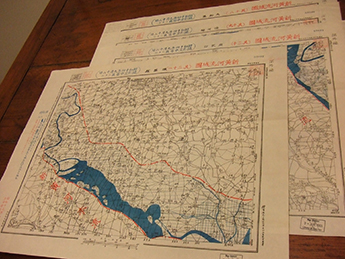
Gaiho-zu retained in the map collection room
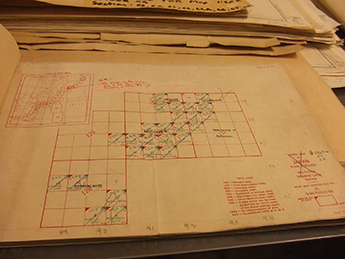
Naikoku-zu retained in the map collection room
To digitize these materials, researchers and subject librarians in the university submit their plans to the Information Technology Services and Digital Strategies department of Suzzallo and Allen Library. This section manages many ofdigitization projects ofthe university, but doesn't perform digitization by itself. It performs digitization for the university's repository services and offers scanners as well as a photograph device built with open source technologies by Senior Computer Specialist Anne Graham, an engineer at this section.
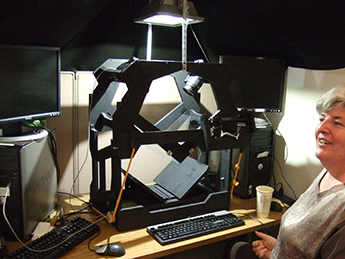
Ms. Graham with the book photographing device she built
This section doesn't digitize all of the university's special collections, as researchers and librarians also acquire financial support through the U.S. Government, the university budget, digital scholarships, and private companies and organizations. The methods the university uses to digitize documents are varied, and include the use of UW departments with equipment as well as tools of outside vendors.
In the experience of digitizing items at the university, the East Asia Library's holdings account for about 10% of the total number of projects. Digitized images are released with consent, so they do not mask personal information. However, there is a policy to take images offline if they are found to include threatening language.
[References]
Comprehensive Guide to the Manuscripts Collection and to the Personal Papers in the University Archives
(The guide was made in 1980 by the Archives and Manuscripts Division of the Library)
The National Archives at Seattle is one of twelve regional facilities operated by the U.S. National Archives. It currently keeps 54,000 cubic feet of permanent records created by Federal government agency offices in the states of Alaska, Idaho, Oregon, and Washington. Records directly connected to Japan can be found in the Department of State holdings, various military record groups as well as in Center for Legislative Records. These records are located at the main buildings in Washington, D.C. and College Park, Maryland.
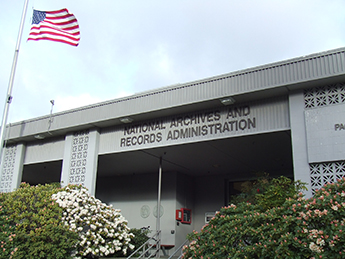
Entrance of the National Archives at Seattle
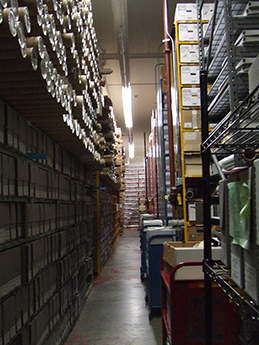
Storage of the National Archives at Seattle
The National Archives at Seattle holds records primarily relating to Pacific Northwest history including those from the Bureau of Indian Affairs, the Bureau of Land Management, the US Forest Service and National Park Service as well as naval installations and has a variety of record groups relating to natural resources. Moreover, the National Archives at Seattle has many materials pertaining to the movement of immigrants from areas including Asia. The Chinese Exclusion Act Case Files often include photographs and interviews with Chinese immigrants, family members and other witnesses. Some files may contain maps. These documents can be used by the descendants of Chinese immigrants to trace ancestors who lived in the United States. Because the law that resulted in the creation of these records only applied to those with Chinese ancestry, the records do not contain information about Japanese immigrants. However, there are also U.S. census records, which have been taken every decade since 1790 and available through 1940, as well as passenger arrival lists available on-line and on microfilm. Among these records, there is a lot of information on Japanese immigrants in the Pacific Northwest.
The records held in Seattle were transferred and retained according to the Record Control Schedule. Consequently, transferred records are to be open to the public immediately, with the exceptions of records containing national security classified information; personnel and medical files which would cause unwarranted invasions of personal privacy; and information which would interfere with fair enforcement proceedings, for example. Moreover, the National Archives at Seattle does not open records to the public of interviews with veterans that were carried out after 1970. We do not hold any records related to veterans.
Materials have been digitized with National Archives and Records Administration guidelines as outlined in the document Digitization at the National Archives. The National Archives at Seattle is digitizing records relating created in Alaska (see http://www.archives.gov/seattle/anchorage-project). Digitized documents from the years, for example, of between 1900 and 1921 pertain to natural resources in Alaska, and genealogy. Digital copies of these documents can be found in the National Archives Catalog located at https://www.archives.gov/research/catalog. The Archives offers document identifier numbers for searches, which operate like JACAR's reference code system.
Located in the suburbs of Seattle and founded in 1916, Boeing retains materials created and obtained by its employees for use.
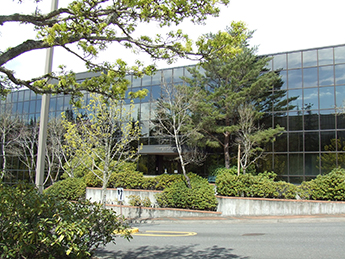
Boeing Archives
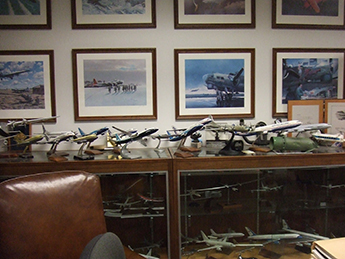
Office of the Boeing Archives
The company has archives documents, including newspapers and magazines since 1930, documents that pertain to civil and military aircrafts. The company has also kept records of its production of many aeronautical vessels, including space shuttles as well as flight tests, employee training, flight demonstrations, and interviews with engineers, manuals for maintenance , operation, records of opinions from users.
The Boeing Archives holds documents of former president William Allen, comprised of business exchanges with employees and others when Allen served as president from 1945 to 1968. In addition to the William Allen Collection, there are also documents relating to Japan, such as contracts for the sale of aircrafts to Japan from the 1930s. These documents are files on aircrafts which Boeing Company licensed for Japanese production and documents on aircrafts that Boeing produced in collaboration with Japanese companies.
In addition to documents that Boeing has created, the archives also holds documents on aircrafts produced by the Douglas Aircraft Company. In 1997 Boeing absorbed the Douglas Aircraft Company, which had stored its archival materials previously at its base in California.
Since most documents in Boeing's archives pertain to security issue, they are not open to the public. However, after gaining the Douglas Aircraft Company, Boeing has been releasing photos and videos from its archives, primarily in its public relations magazines, which are available online ( >> GO), Boeing brochures and television (you can view videos on the Boeing 100th anniversary page >> GO). Some of documents and their copies are exhibited in the Museum of Flight.
Digitization enhances long-term retention of documents, but given the process's cost. Boeing only digitizes documents when it'd be helpful to do so. Currently only about 5 per cent of the total holdings has been digitally archived.
|
Period
|
Event
|
Note
|
Link
|
|
October 29
to December 17, 2016 |
Featured Exhibition "The Booklovers"
|
How did bibliophiles, particularly book collectors, assemble, store and use their texts?
Nagaaki Ichihashi (1773-1814), domain lord of Nishoji-han (currently Gamo-gun, Shiga prefecture), provided 30 Chinese classics that he thought were the best of his collections and offered them to the Yushima Seido in a wish for development of scholarship.
Similarly, the collections of Kenkado Kimura (1736-1802), one of the leading merchants in Osaka, were posthumously transferred to the Tokugawa Shogunate.
This exhibition introduces book collectors who consequently contributed greatly to the collections that developed into the National Archives and shows the profound world of books.
|
|
|
Period
|
Event
|
Note
|
Link
|
|
October 11
to December 27, 2016 |
Special Exhibition : "Introduction to the End of the Tokugawa Period"
- Part II : "Encountering the West: Walking the Bakumatsu" |
The exhibit will feature documents on Japan's encounter with Western civilization and Western diplomatic missions in Japan in the late Tokugawa period from Tsushin zenran and Zoku Tsushin zenran.
|
|
[Postscript]
Thank you for reading the JACAR Newsletter No.21, and we hope you enjoyed it.
In this issue, we presented "Documents Spotlight" about prewar diplomatic telegrams and official notes.
To make the newsletter an even more useful reference in the future, we would deeply appreciate any comments or feedback on * THIS FORM *.
Please email us if you would be interested in a member of JACAR presenting at your organization about our institution and its resources. We go to schools, research conferences, and a range of other institutions.
Leaflets about JACAR are available in English, Japanese, Chinese, and Korean, so if you would like copies, please contact us.
An email about the JACAR Newsletter has been sent to everyone who requested a copy as well as those who have exchanged business cards with JACAR staff members. If you do not wish to receive future e-mails, please let us know.
[Reference] TEL : +81-(0)3-5805-8801 E-MAIL : jacar_enquire@archives.go.jp

![* Click to Enlarge [Image 1] Title : 24. Consulate in Zhangjiakou (2nd image)](img/021_content01_01_01.jpg)
![* Click to Enlarge [Image 3] Title : Partition 3 (1st image)](img/021_content01_03_01.jpg)



